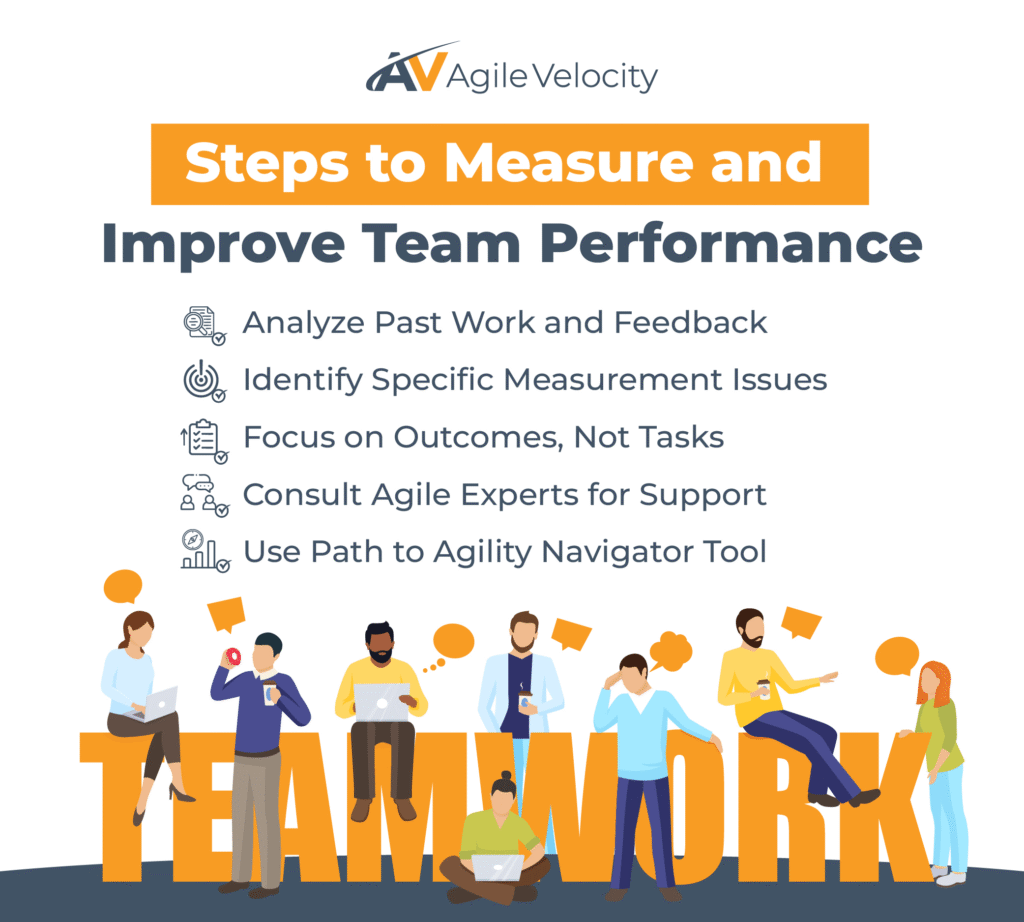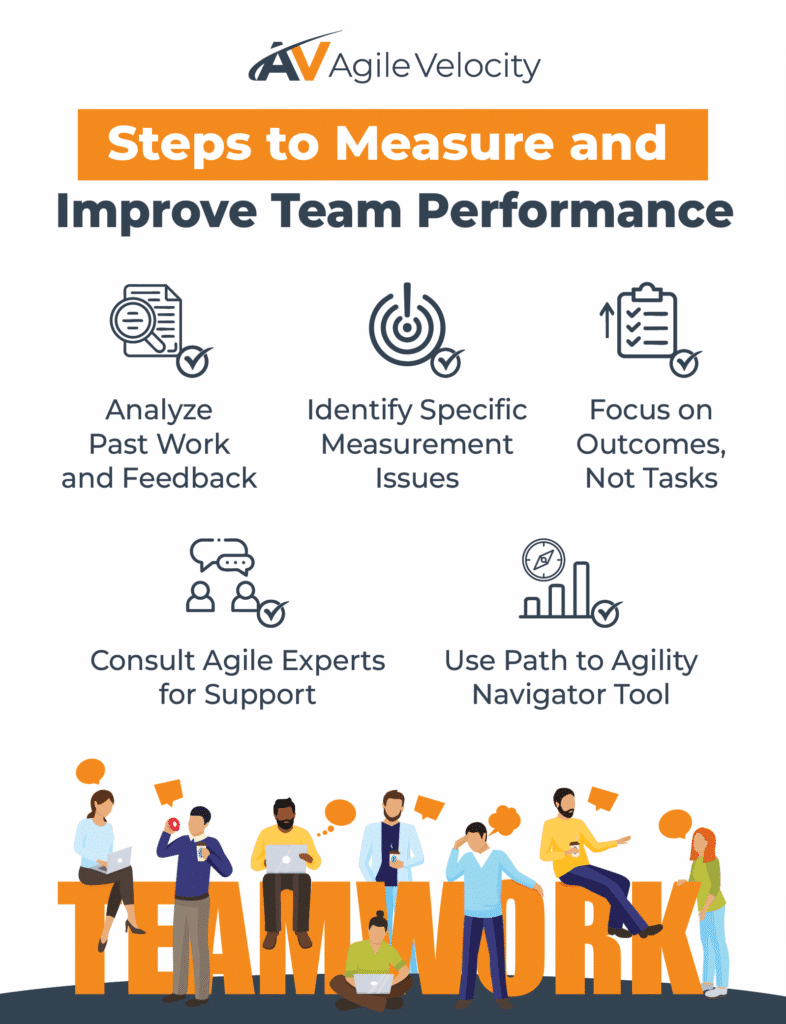Achieving success in your Agile journey requires more than adopting new practices. Leaders often find that even when following frameworks like Scrum, Kanban, or even SAFe®, results can sometimes seem unpredictable. Without straightforward Agile team metrics, missed deadlines, unclear priorities, and low engagement are common challenges.
Agile Velocity understands these hurdles. With a friendly, collaborative approach and tools like the Path to Agility® Navigator, your organization can shift from guesswork to measurable progress. In this article, we explore why tracking progress is essential, highlight common obstacles, and share practical steps to ensure your Agile journey delivers true value.
Why Measuring Team Progress in Agile Is Essential
Measuring progress in Agile means capturing more than just completed tasks. It involves setting clear, outcome-oriented metrics that connect daily activities with broader business goals. When teams see how their work impacts strategic outcomes, they become more focused, motivated, and driven—leading to improved delivery timelines, stronger stakeholder trust, and enhanced team morale.
Connecting Progress Tracking to Business Goals
- Strategic Alignment: When teams understand how their efforts drive business outcomes, every task gains meaning.
- Predictability: Clear metrics simplify forecasting delivery dates and assist in managing stakeholder expectations.
- Enhanced Customer Satisfaction: Accurate progress tracking builds confidence and improves relationships with clients.
By emphasizing outcomes instead of just activities, organizations can ensure that every deliverable adds real value.
Signs Your Agile Practices Aren’t Delivering Full Benefits
Even with regular Agile events and sessions, your practices may not be delivering the expected results. Consider these warning signs:
Missed Deadlines and Unpredictable Timelines
Consistently missed deadlines or difficulties in predicting delivery dates indicate current measurement tools may not be capturing true progress.
Lack of Clear Insights and Bottlenecks
Agile events like the Daily Scrum or Sprint Review should provide clarity on progress and highlight bottlenecks. If these meetings don’t yield actionable insights, it may be time to revisit which data points are tracked.
Teams Not Demonstrating Measurable Improvement
If team members appear “busy” without concrete improvements or struggle to articulate the impact of their work, consider reassessing your measurement system. Visible, quantifiable results are key for maintaining focus on valuable delivery.
Misalignment with Business Goals
Agile practices must align with your organization’s strategic objectives. If there is a disconnect between sprint outcomes and business priorities, achieving overall success becomes challenging.
The Importance of Outcomes-Based Measurement in Agile Practices
Traditional metrics that merely count tasks fall short in Agile environments. Instead, outcomes-based measurement emphasizes the real impact of work.
Why Focusing on Outcomes Works Better
- Clear Purpose: Teams answer key questions like “What does success look like?” and “Why are we doing this?”
- Prioritization: By aligning activities with measurable business goals, teams eliminate busy work and focus on high-value tasks.
- Data-Driven Feedback: Continuous improvement is achievable when metrics truly reflect progress rather than just activity counts.
Key Benefits of an Outcomes-Based Approach
- Enhanced Decision Making: Clear metrics enable better prioritization and resource allocation.
- Sustainable Improvement: Focusing on outcomes nurtures a culture of learning and adaptation.
- Increased Team Engagement: When progress is directly linked to business impact, teams feel more motivated to pursue excellence.
The Challenges of Measuring Progress in an Agile Environment

Agile’s iterative and flexible nature can complicate progress measurement. Many organizations encounter challenges such as:
Over-Reliance on Vanity Metrics
Metrics like the number of completed user stories can seem positive without truly capturing meaningful progress. Authentic improvement comes from tying these numbers to tangible business value.
Disconnect Between Activities and Outcomes
If teams operate in isolation or employ outdated methods, daily tasks may not reflect strategic goals. Without a clear framework, understanding how each effort contributes to success is difficult.
Lack of Effective Visualization Tools
Manual tracking methods such as spreadsheets often fail to capture Agile’s dynamic nature. This may lead to missed trends and slow response times when adjustments are needed.
Forecasting Difficulties
Agile’s flexibility can hinder traditional forecasting efforts. Without mechanisms to tie short iterations to long-term planning, timelines may become unreliable.
Introducing Agile Velocity: Champions of Organizational Agility
Agile Velocity is dedicated to guiding organizations through meaningful Agile transformations. Rather than offering one-size-fits-all solutions, Agile Velocity works to support each client’s unique path, encouraging teams to build capabilities that evolve alongside emerging challenges. Their approach is designed to foster greater self-sufficiency and promote continuous, long-term improvement.
A Focus on Real Outcomes, Not Just Frameworks
Agile Velocity moves beyond the mere implementation of frameworks like Scrum, Kanban, or SAFe. Its mission is to deliver predictable timelines, improved quality, and faster market responses by aligning every Agile effort with your organization’s strategic goals.
Built on Collaboration, Transparency, and Continuous Improvement
Agile Velocity fosters a culture where feedback is valued, data drives decision-making, and each team member plays a part in transformation. The approach emphasizes:
- Open communication and mutual trust.
- Hands-on coaching for roles such as Scrum Master, Product Owner, and team members.
- Tailored strategies that align with your distinctive business needs.
Driving Sustainable Change Together
By partnering with clients, Agile Velocity aims to help teams mature in capability and adapt to new challenges over time. Their model helps organizations progress toward self-sufficiency, enabling continuous, long-term improvement.
How Path to Agility Navigator Transforms Progress Measurement
Path to Agility Navigator is a tool created by Agile Velocity that is designed to convert complex progress data into actionable insights. It aims to help organizations measure efforts against real business outcomes.
Gain Clarity on Team Performance
Path to Agility Navigator provides a comprehensive view of current team performance. It highlights strengths and identifies bottlenecks, offering a clear roadmap for improvement.
Use Data-Driven Insights to Track Progress
In keeping with agile principles, the tool emphasizes the importance of actionable, milestone-driven data. This approach ensures that decisions are informed by data reflecting true progress rather than superficial metrics.
Bridge the Gap Between Daily Activities and Strategic Goals
By visually linking daily tasks to high-level objectives, Path to Agility Navigator fosters alignment between sprint work and broader business goals. This supports teams in prioritizing work that matters and delivering measurable business value.
Foster Long-Term, Sustainable Improvement
Beyond tracking performance, the tool is designed to guide continuous improvement, helping teams inspect, adapt, and evolve with every iteration.
Agile Velocity’s Comprehensive Solutions for Agile Teams
Agile Velocity offers a range of services to support your Agile journey at every stage. These solutions are designed not only to help your team operate efficiently today but also to prepare you for future challenges.
Agile Coaching for Sustainable Agility
Experienced Agile Coaching helps teams adopt Agile methodologies practically and sustainably. Coaches work with Scrum Masters, Product Owners, and team members to apply proven techniques immediately.
Strategic Alignment with Lean Portfolio Management
Lean Portfolio Management connects strategic objectives with everyday operations. By focusing on high-value projects, teams can streamline work, improve forecasting, and secure better outcomes.
Tailored Agile Transformation Services
Agile Velocity offers end-to-end transformation services that address cultural change, leadership evolution, and process optimization, ensuring that transformation goes beyond process tweaks to evolve how your organization operates.
Upskilling Through Corporate and Public Training Workshops
Training workshops boost team capabilities and confidence. Sessions covering certification paths such as Certified ScrumMaster® and Certified Product Owner® help practitioners at all levels enhance their skills.
Adapting to Modern Needs with AI Solutions and Return to Office Events
Agile Velocity keeps pace with modern business demands through tailored AI Solutions and Return to Office Events, blending remote flexibility with in-person collaboration.
Agile Staffing to Build High-Performing Teams
Securing the right talent is essential. Agile Velocity’s Agile Staffing services assist organizations in attracting and onboarding skilled professionals to meet key business objectives.
Practical Steps to Start Measuring and Improving Team Progress
Ready to start measuring progress more effectively? Follow these steps to advance your Agile journey:
- Reflect on Your Current Practices
- Review recent sprints or iterations.
- Gather candid feedback from team members.
- Identify points where deadlines are missed or outcomes seem disconnected.
- Identify Specific Pain Points
- Determine whether your current metrics provide actionable insights.
- Look for inconsistencies in forecasting or delivery.
- Identify bottlenecks that hinder measurable progress.
- Shift Focus to Outcome-Oriented Goals
- Replace simple task counts with metrics that reflect improvements in cycle time, customer satisfaction, or other key outcomes.
- Clearly define what success looks like in measurable terms.
- Ensure every sprint goal is aligned with high-level business objectives.
- Seek Expert Guidance When Needed
- Consider leveraging Agile Velocity’s coaching support through our expert coaching services.
- Use expert advice to refine your measurement and transformation strategies.
- Adjust improvements based on data-driven insights.
- Leverage Path to Agility Navigator
- Utilize the tool to gain a clear, data-driven view of your progress.
- Prioritize actionable improvements and refine workflows accordingly.
- Ensure every adjustment ties directly to measurable business outcomes.
Maximizing the Benefits of Your Agile Journey
As organizations refine their Agile practices, it is essential to continuously evaluate and evolve how progress is measured. Long-term success in Agile Transformation comes from embedding regular review cycles and feedback processes into day-to-day workflows.
One effective approach is incorporating comprehensive reviews outside standard Sprint events. By assessing key performance indicators quarterly, teams can identify emerging trends and adapt strategies as needed. Additionally, cross-functional meetings foster innovation by allowing different perspectives to share insights, often leading to creative solutions for persistent challenges.
Recognizing and celebrating both small and significant improvements is vital. This practice creates an environment where every milestone, no matter how modest, contributes to the overall success. Leaders should regularly set aside time for reflective sessions, enabling teams to discuss successes, analyze setbacks, and identify areas for refinement. This ongoing cycle of learning and adaptation positions teams to respond effectively to dynamic priorities.
By leveraging targeted coaching sessions and advanced tools like Path to Agility Navigator, organizations can compile detailed feedback and translate insights into actionable strategies. The focus remains on aligning daily actions with strategic business objectives to build a more agile, responsive, and high-performing team.
Continuous Learning for Lasting Agile Success

Commitment to continuous learning is key to maintaining momentum on your Agile journey. Regular reviews and adaptive planning empower teams to address shifting demands with flexibility and insight. By embedding retrospective analysis into routine practices, teams can perpetually identify areas for improvement, ensuring that progress measurement evolves alongside the organization. This focus on learning not only reinforces current success but also lays the foundation for future growth.
Unlock Your Agile Potential Today
Measuring your team’s progress is the heartbeat of a successful Agile transformation. It goes beyond simple task tracking to establish a transparent, outcome-driven process that links daily effort to overarching business objectives. Agile Velocity supports your transformation journey by combining expert coaching with smart tools like Path to Agility Navigator—tools that emphasize actionable data and alignment with business goals.
If you’re ready to unlock your Agile potential, take the next step in refining your progress measurement. Discover how Agile Velocity’s comprehensive approach can energize your team and drive lasting business impact. Contact our team today to begin transforming your Agile practices.





